Creating and Defining Projects
|
Page Name |
Definition Name |
Usage |
|---|---|---|
|
PROJECT_GEN_01A |
Create or update a project. This page operates in deferred processing mode. |
|
|
PC_CHART_DISPLAY |
Display a project and it’s activities in a graphical manner. |
|
|
PC_ADD_DATES_SEC |
Optionally enter project baseline start and finish dates, early start and finish dates, actual start and finish dates, and late start and finish dates. |
|
|
PROJECT_GEN_01 |
Define various project options, project currency, and analysis groups. |
|
|
Assign To Project Tree Page |
PC_PROJ_TREE_SEC |
Add a project to a project tree. |
|
PROJECT_P6_OPTN |
Set up Primavera P6 integration options for a project. |
|
|
PROJECT_GEN_02 |
Define options if you use PeopleSoft Program Management. |
|
|
PROJECT_MGR |
View and track project managers. Enter program managers if you use PeopleSoft Program Management. |
|
|
PROJECT_LOCATION |
Assign the physical location of the project. |
|
|
PROJECT_SCHED |
Track time spent on stages of a project. |
|
|
PROJECT_APPROVAL |
Specify which project events require approval, who is authorized to approve the events, and in what order the events must be approved. Approve a project event or check on approval status. |
|
|
PROJ_JUSTIFY |
If your company employs an approval cycle for projects, enter a reason for justifying a project-related action. |
|
|
PC_PROJ_USER |
Specify additional, project information for the organization. |
|
|
Security by Permission List Page |
PROJECT_SEC_OPRCLS |
View and add permission lists to which the project was attached. This page is available in the Project General component only if security is defined using permission list, list-based security. For additional information about Project Security, see Understanding Project Security |
|
PROJECT_SERVICES |
Track billing, costing, and burdening project rates and view contracts integration information that is associated with a project. |
|
|
PROJECT_DOC_01 |
Attach, view, and delete project-related files. |
|
|
Project Definitions - Asset Integration Rules Page |
PC_AM_RULE_PRJ |
Define integration with PeopleSoft Asset Management at the project level. for additional information about setting up asset integration rules, see Understanding Asset Capitalization Processes |
|
Project Definitions - Budget Alerts Page |
PC_BUD_PROJ_ALERTS |
Define budget alert thresholds at the project level for cost budgeting to alert the project manager of potential cost overruns at the project level. For additional information about setting up budgets and budget alerts, see Setting Up Budgets in PeopleSoft Project Costing |
Use the Project Definitions - General Information page (PROJECT_GEN_01A) to create or update a project.
This page operates in deferred processing mode.
You can use the Project Definitions - General Information - Keyword Search page to perform keyword searches for projects. Keyword search allows you to execute a deeper, more free-form search, to access application data. For additional information on keyword searches, see the product documentation for PeopleTools: Search Technology, Working with Keyword Search modes.
Navigation:
This example illustrates the fields and controls on the Project Definition - General Information page. You can find definitions for the fields and controls later on this page.
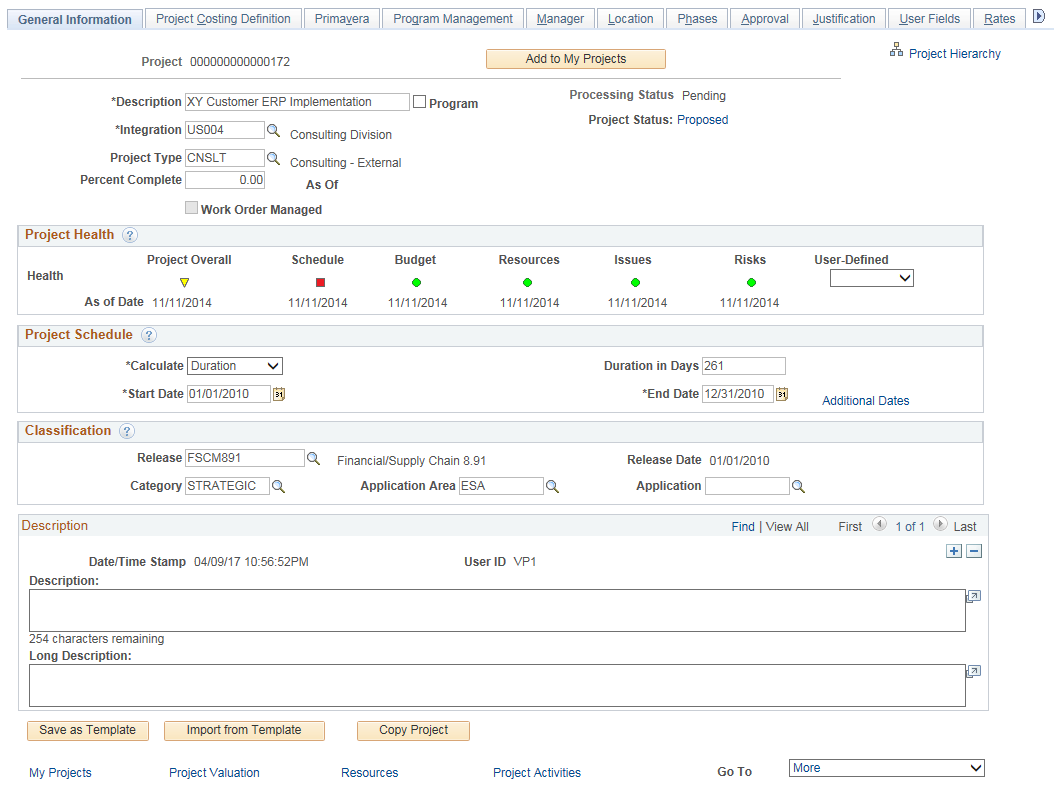
Field or Control |
Description |
|---|---|
Create |
Select an option on the General Information - Add a New Value page to create a new project. Available options are: Blank Project: Creates a new transactional project and opens the Project Definitions - General Information page. Project Template: Creates a new project template and opens the Project Definitions - General Information page. Project from Copy: Opens the Copy Project page so that you can identify the source project, target project, and copy options. Project from Microsoft Project: Opens the Create Project from Microsoft page so that you can identify key project fields and integration options to create a new project from an existing Microsoft Project. Project from Template: Opens the Create Project From Template page so that you can identify the project template, new start date, and project details to include in the new project. Only active project templates are available for creating the project. |
Project |
Leave the default value of NEXT for the system to assign the next sequential project ID, or override the default value with a unique project ID. |
Add to My Projects |
Click to add this project to the list of projects that appear on your My Projects page. This button appears only when Manual or Auto Populate, Allow Override is selected in the My Projects Setup field on the Installation Options - Project Costing Page. |
Program |
Select to designate this project as a program or summary project. When this option is selected, the system prevents you from adding activities to the program because only projects can have activities. If you try to select this option for a project that already has activities, a message appears indicating that the project cannot be changed to a program because it has activities associated with it, and you must either remove the activities from the existing project or create a new program. After you convert a project to a program by selecting this option and saving your changes, the project ID of this program is available in various program and parent project ID prompt list fields that appear on pages throughout the PeopleSoft Program Management system. |
Processing Status |
Displays the processing status that is associated with the project status. The system uses the processing status to restrict incoming transactions. You map project status types to processing statuses during implementation on the Project Status Defaults page. Processing statuses are: Active: Projects can be selected from prompt lists in PeopleSoft feeder systems, allowing transactions from the feeder systems to be attributed to the project. This is the default processing status for new projects if you use PeopleSoft Project Costing without PeopleSoft Program Management. Inactive: Projects do not appear in prompt lists in PeopleSoft feeder systems. Pending: Projects are not active yet, but you can begin some planning, such as creating a budget and project team. You cannot charge cost transactions to pending projects. This is the default value for new projects if you use PeopleSoft Program Management. Template: Project Template is associated with this status. |
Template Status |
Displays the project template status. The status can be changed between Active and Inactive for the template. The display also includes if the project template is Public or Private. This field appears only if the Processing Status is Template. |
Integration |
Enter the integration template that is used to integrate this project with other financial applications. Available values are from the Integration Template table (PC_INT_TMPL). The default value is based on the integration template that is defined on the User Preferences page. |
Project Status |
Enter the project's status when you are in add mode. After you save the project for the first time, the Project Status field becomes read-only on this page and appears as a link to the Project Definitions - Status page so that you can update the status. If you use PeopleSoft Project Costing without PeopleSoft Program Management, the default value of this field is based on the Default Project Status field value on the Project Status Defaults page that maps to the active processing status. If you use PeopleSoft Program Management, the default value of this field is based on the Default Project Status field value that maps to the Pending Processing Status. The system updates the Processing Status field value based on the value that you enter in this field. You set up project status type values and project status default values during implementation. |
Project Type |
Select a project type. Use project types to:
You set up project types during implementation on the Project Types page. See Project Types Page. |
Contract Number |
Click the contract number link to access the contract header (General) page and the contract Lines page. This field is only displayed when in update mode and the project is associated with a grants project. |
|
Click to access the Award page for the contract and project. This field is only displayed when in update mode and the project is associated with a grants project. |
Percent Complete |
Displays the percentage of the project completed based on the calculation method that you define on the Project Costing Definition page. If you select Manual in the Calculation Method field on the Project Costing Definition page, you can enter a value in the Percent Complete field on this page. If you select a calculation method of Budget Amount, Budget Hours, Duration, Forecast Amount, or Forecast Hours, the system automatically calculates and displays the percent complete value. The Duration calculation method is available only if you use PeopleSoft Program Management. |
As Of (percent complete) |
Displays the date that you enter the percent complete data. The date and time appear when you enter a percent complete value and save the page. |
Project Health |
Enter a value that represents the project's health. If you use PeopleSoft Project Costing without PeopleSoft Program Management, select Fair, Good, or Poor from the drop-down list box. A visual indicator that represents the project's overall health appears on the My Projects page. If you use PeopleSoft Program Management, fields appear that indicate health for Project Overall, Schedule, Budget, Resources, Issues, Risks, and User-Defined. Values for these fields are based on the default methods of calculating project health that are specified on the Program Management Options - Health Options page for the business unit. See Health Options Page. |
As Of Date (project health) |
Displays the date that you enter the project health data. |
Work Order Managed |
Select to designate the project as a work order-managed project, which indicates that the project is managed with work orders in PeopleSoft Maintenance Management instead of by a project manager in Project Costing. This check box becomes unavailable when you save the Project Definition page and an activity is associated with the project. If an activity is not associated with the project, and you save the page, the field remains open and available. This field appears only if you use PeopleSoft Maintenance Management. The default value is deselected. See Creating Work Orders and Work Order-Managed Projects in PeopleSoft Project Costing. |
Project Schedule
Field or Control |
Description |
|---|---|
Start Date |
Select the project start date. The start date cannot be after any of the project's activity start dates. |
End Date |
Select the date that the project ends. The end date cannot be before any of the project's activity end dates. |
Additional Dates |
Click to access the Additional Dates page, where you can enter project baseline start and finish dates, early start and finish dates, actual start and finish dates, and late start and finish dates. |
Calculate |
Select Start Date, End Date, or Duration (days) to specify which one of these three fields is calculated by the system based on the values that you enter for the other two fields. For example, select End Date for the system to calculate the end date based on the values that you enter for start date and duration. The default value is based on the project calculation method that is specified on the Program Management Options page for the business unit. The Calculate field is available only if you use PeopleSoft Program Management. |
Duration in Days |
Enter the number of business days between the start date and end date of the project or program. This field is available only if you use PeopleSoft Program Management. |
Classification
The fields in this group box appear only if you use PeopleSoft Program Management.
See Setting Up General Control Data.
Field or Control |
Description |
|---|---|
Release |
Select a release to further classify the project. Available values are based on active releases in the Release table (PGM_RELEASE_ALL). You can specify a release for projects in any processing status. This field appears only for projects, not programs. You cannot specify releases for programs. The release description appears when you enter the release. |
Release Date |
Displays the current target release date when you enter the release. This field appears only for projects, not for programs. |
Category |
Select a category to further classify the project. Available values are based on the categories in the Active Categories table (PGM_CATEGORY_AC) that are valid for the business unit based on the SetID mapping. |
Application Area |
Select an application area to further classify the project. Available values are based on the application areas in the Active Application Areas table (PGM_APPLAREA_AC) that are valid for the business unit based on the SetID mapping. |
Application |
Select an application. Available values are based on the application area. |
Additional Pages
Additional buttons and links appear on the page for existing projects or when you save new projects.
Field or Control |
Description |
|---|---|
Save as Template |
Click to access the Save as Template page to save an existing transactional project as a project template. Only active project templates are available for selection. The Save as Template button appears on this page for pending and active projects. This field appears only for projects and not for programs. |
Import from Template |
Click to access the Import From Template page and import data into an existing transactional project from a project template. Only active project templates are available for selection. The Import from Template button appears on this page for pending projects. This field appears only for projects and not for programs. |
Copy Project |
Click to access the Copy Project page and modify an existing project or create a new project with information from this project. The Copy Project button appears on this page for pending and active projects. This field appears only for projects and not for programs. |
My Projects |
Click to access the My Projects page to view a list of your projects and templates. |
Project Valuation |
Click to access the Project Valuation page. |
Project Team |
Click to access the Project Definitions - Team page to view and modify membership to the project team. This link appears if you use PeopleSoft Project Costing without PeopleSoft Program Management. |
Resources |
Click to access the Resources page to view and modify the list of project team resources. This link appears if you use PeopleSoft Program Management. |
Project Activities |
Click to access the Project Activities page to view and modify the project's activities. |
More |
Select an option to access project-related pages: Integrate with MSProject: Access the Integrate with Microsoft Project page to create or update a project in Microsoft Project with data in a PeopleSoft Project Costing or PeopleSoft Program Management project. See Integrate with Microsoft Project Page. Manager Workbench: Access the Manager Workbench to view a summary of the project's health scorecard, milestones, issues, risks, change requests, and project deliverables. This option appears only if you use PeopleSoft Program Management. See Reviewing Programs and Projects. PC Chartfield Default for WO: Access the Work Order Project Chart field Mapping page (WM_PC_DFLT_CFS) for a business unit, work type, and service group combination to specify default project ChartField values for work order tasks. This option appears only if you use PeopleSoft Maintenance Management. See Setting Up Rules and Data Related to PeopleSoft Project Costing. Project Budgeting: Access the Budget Plan page, if a budget plan exists for this project, to view budget plans associated with the current project. See Creating and Defining Budget Plans. Project Defaults for WO: Access the Work Order - Projects Association page to specify default work order values on projects. This option appears only if you use PeopleSoft Maintenance Management. See Setting Up Rules and Data Related to PeopleSoft Project Costing. Project Initiation Checklist: Access the Project Initiation Checklist page to view a list of steps that are required to set up, initiate, and track a project. The page also provides links to the components where each step of a project is implemented. See Initiating Projects by Using Project Initiation Checklists. Project Request: Access the Project Request page if the project is associated with a project request. This option appears only if you use PeopleSoft Program Management. Project Status: Access the Project Definitions - Status page to view or define project status. See Maintaining Project Status. Status Report Frequency: Access the Status Report Frequency page to define or view how often status reports are required for the project. This option appears only if you use PeopleSoft Program Management. Status Report Reminder: Access the Status Report Reminder run control page to send email notifications to project team members as a reminder of status report due dates. This option appears only if you use PeopleSoft Program Management. |
|
Click to access the Project Hierarchy page to view a project and it’s activities in a graphical manner. Note: You must create atleast one activity to be able to view the project hierarchy link and icon for a new project. |
Use the Project Hierarchy page (PC_CHART_DISPLAY) to display a project and it’s activities in a graphical manner.
Navigation:
Click Project Hierarchy icon on the Project Definitions - General Information page.
This example illustrates the fields and controls on the Chart Options for Vertical Orientation and Navigation. You can find definitions for the fields and controls later on this page.
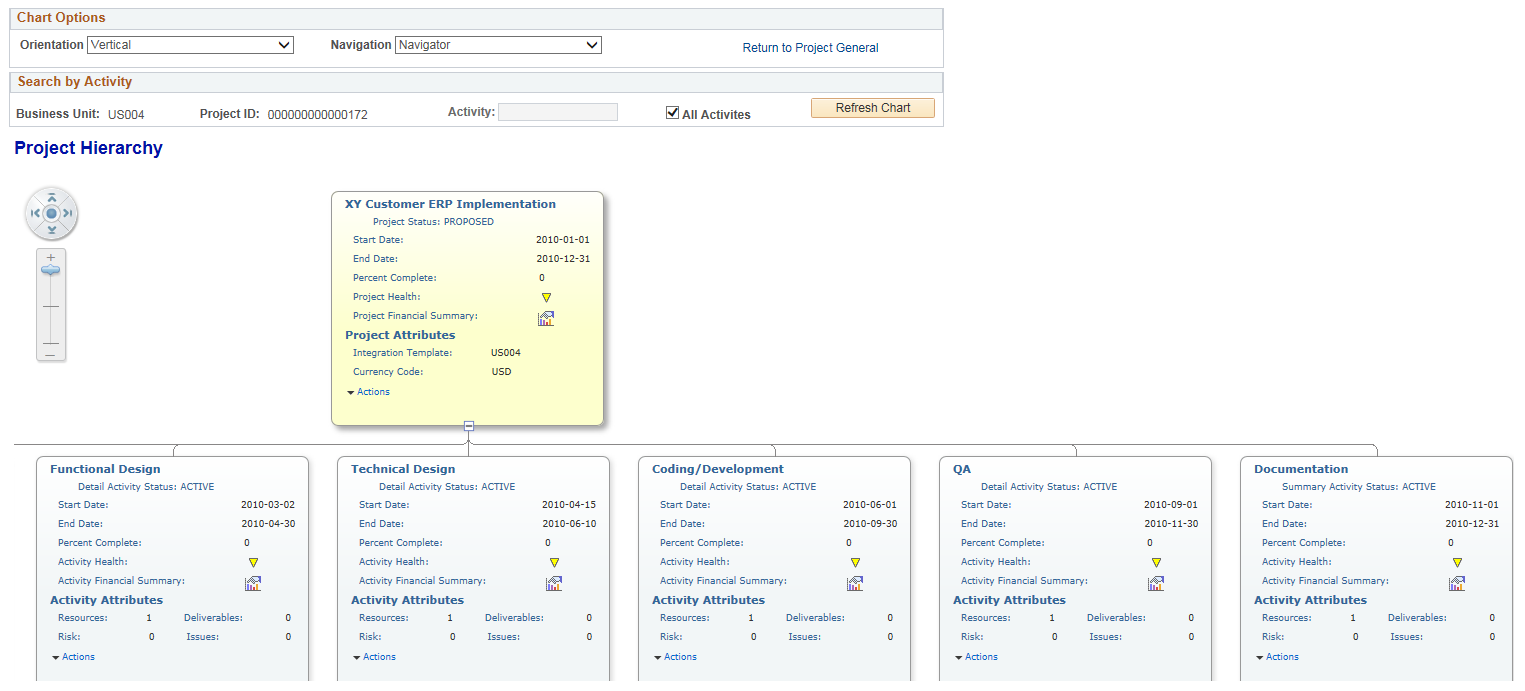
Field or Control |
Description |
|---|---|
Orientation |
Enter the orientation for the graphic project view. |
Navigation |
Enter the navigation type for the graphic project view. |
The project is displayed at the top of the hierarchy chart and the activities as part of the breakdown structure. A child summary activity is also displays if present. You can click on any of the related content actions, basis your user security role.
Note: Chart Options for the project hierarchy page permits a 3 schema level zoom to view maximum and minimum information for each project and activity node.
For more Information see section, Using the OrgChart Class, in PeopleTools: PeopleCode API Reference documentation.
Use the Additional Dates page (PC_ADD_DATES_SEC) to optionally enter project baseline start and finish dates, early start and finish dates, actual start and finish dates, and late start and finish dates.
Navigation:
Click Additional Dates on the Project Definitions - General Information page.
This example illustrates the fields and controls on the Additional Dates page. You can find definitions for the fields and controls later on this page.

You can use the additional dates fields as needed for information and reporting. They do not serve a functional purpose in Project Costing.
Field or Control |
Description |
|---|---|
Baseline Start Date and Baseline Finish Date |
Enter the projected start and finish dates for the project. |
Early Date Start and Early Finish Date |
Enter the earliest possible project start and completion dates. |
Actual Start Date and Actual Finish Date |
Enter the actual project start and completion dates. The system can automatically populate these fields when you integrate with the Microsoft Project scheduling application. |
Late Start and Late Finish Date |
Select the latest possible project start and completion dates. |
Use the Project Definitions - Project Costing Definition page (PROJECT_GEN_01) to define various project options, project currency, and analysis groups.
Navigation:
This example illustrates the fields and controls on the Project Definitions - Project Costing Definition page. You can find definitions for the fields and controls later on this page.
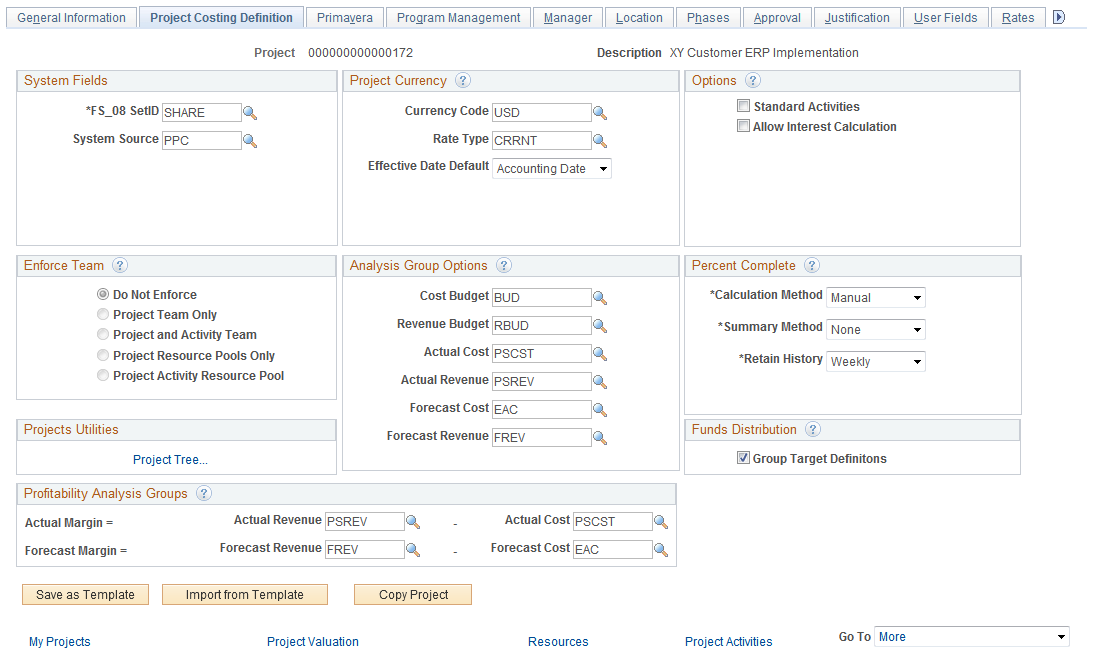
System Fields
Field or Control |
Description |
|---|---|
FS_08 SetID |
Enter a SetID in cases in which multiple project business units relate to the same general ledger business unit. Because a general ledger business unit can relate to only one SetID or project business unit combination, the FS_08 SetID field enables you to associate the SetID that the general ledger business unit is using in the FS_08 record group. If you use an integration template that relates the general ledger business unit to a different SetID, the FS_08 SetID field changes to the correct SetID value that is used in the FS_08 record group. |
System Source |
Enter the origin of a project, such as a third-party application or an online entry page in another PeopleSoft application. The default value is PPC (Project Costing online entry page). Available values are based on the translate values in the System Source field (SYSTEM_SOURCE) properties. |
Auto Review for Period of Performance |
Select to automatically review and approve period of performance exceptions for the particular project. This check box defaults from Project Type settings. Note: This check box is displayed only if Review Required for Period of Performance check box is selected on the Installation Options - Project Costing Integration Page. |
Project Currency
The system uses the currency code and rate type that you define in this group box when you review transactions online through the Transaction List page. The value in the Project Amount field on the Transaction Detail page is not stored in Project Costing tables. It is calculated each time that you access the page.
Field or Control |
Description |
|---|---|
Currency Code |
Indicate the type of currency used to track costs. The default value is based on the business unit. |
Rate Type |
Select the default exchange rate type for the project. The default value is based on the business unit. |
Effective Date Default |
Select the default date on which the currency code becomes effective. This field is used in conjunction with the rate type and currency code. Available options are: Acct Date: Accounting date. Cur Date: Current date. Trans Date: Transaction date. Note: When source transactions are entered into Project Costing in a currency that is different from the project currency code, the converted value is not stored in any Project Costing table. However, you can view the project currency amount for an individual transaction on the Transaction List page. The system uses the effective date default to determine which date to use when converting the source transaction amount to the project currency code when you view the transaction online. |
Options
Field or Control |
Description |
|---|---|
Standard Activities |
Select to restrict this project's activities to a predefined list based on SetID and project type. By default, this check box is deselected. |
Allow Interest Calculation |
Select to include costs that are incurred by all activities belonging to the project in interest calculations. Only projects and activities with a processing status of Active are eligible for interest calculation. By default, this check box is deselected. If you select the Allow Interest Calculation option at the project level, the system automatically selects the Allow Interest Calculation option as the default value for all activities that are added to the project. You can override the project default value for individual activities. |
Add me to Project Security |
This is a setup option that appears if you use project security and you are creating a new project from a blank project. The field remains visible until you save the Project Costing Definition page and refresh the component. The behavior of the Add me to Project Security option is based on the type of security that is enabled on the Security Options page. For example, if you use team-based security, use this option to automatically add yourself—the employee who is associated with the user ID that is logged into the system—to the project team with security access that is determined by your project role. Alternatively, if you use user, tree-based security, use this option to automatically add the new project to a project tree and grant yourself access to the project based on your project role. This list discusses the behavior of the Add me to Project Security option based on the project security options that you can select on the Security Options page:
|
Project Role |
This field appears in conjunction with the Add me to Project Security field. Select your project role—the project role of the user ID who is creating the project. The project role contains a security profile that determines your access to projects and activities, such as no access, read-only, or read/write access. The project role can also specify the transactions to which you have access. |
Auto Review for Billing |
Select to automatically designate transactions for this project as reviewed, indicating that the transactions do not require review by the project manager before being sent to PeopleSoft Billing. This option is available only if the Review Required for Billing option is selected on the Installation Options - Project Costing Integration page. |
Enforce Team
Designate who can charge time and expenses to a project or activity by selecting an option in the Enforce Team group box. These options are available for selection at the project level if you selected the Decide at the Project Level option on the Project Costing Options page for the business unit.
Field or Control |
Description |
|---|---|
Do Not Enforce |
Select to indicate no project team restriction. This project is available for employees to charge time and expenses regardless of their membership to the project team. The Products drop-down list box does not appear when you select this option. |
Project Team Only |
Select to indicate that only members of the project team can charge time and expenses to the project. The Products drop-down list box appears for you to define the charge restrictions for project team members. |
Project and Activity Team |
Select to indicate that only members of the project and activity teams can charge time and expenses to the project. The Products drop-down list box appears for you to define the charge restrictions for project and activity team members. |
Products |
Select the kind of charges to allow for a project or activity. This field is available only if you select an enforce team option of Project Team Only or Project and Activity Team. Available product options are: Exp and TL (Expenses and Time and Labor): Allows members of the project or activity team to charge to the project from both PeopleSoft Expenses and PeopleSoft Time and Labor. Expenses: Allows members of the project or activity team to charge to the project from PeopleSoft Expenses. Time&Labor: Allows members of the project or activity team to charge to the project from PeopleSoft Time and Labor. |
Project Resource Pools Only |
Select to enable only resources that belong to the project's resource pools to charge time and expense against the project in the PeopleSoft Expenses system. If you select this option, the Expenses value appears in the Products field and is not editable. This option appears if both PeopleSoft Program Management and PeopleSoft Resource Management are installed. |
Project Activity Resource Pool |
Select to enable only resources that belong to an activity's resource pools to charge time and expense against the activity in the PeopleSoft Expenses system. If you select this option, the Expenses value appears in the Products field and is not editable. You cannot select this option if the Activity Costing Level option is selected as the project charging level on the Program Management Options page. This option appears if both PeopleSoft Program Management and PeopleSoft Resource Management are installed. See Program Management Options Page, Activity Resource Pools Page. |
Note: The PeopleSoft Time and Labor application does not enforce project activity team. If you select the Project and Activity Team option, and select the Exp and TL or Time&Labor product option, the system restricts PeopleSoft Time and Labor users for projects to which they can charge time. However, PeopleSoft Time and Labor users can charge time to any activity on a particular project if they have security access to the project.
Analysis Group Options
Default values for these analysis group options are based on the Installation Options - Project Costing page. You can override the default values for the project.
Note: If you are using PeopleSoft Fluid pages to manage projects and you change an analysis group on this page, you should run the Refresh Reporting Tables process (PC_SUM_PR) using the Refresh Reporting Tables Page.
Field or Control |
Description |
|---|---|
Cost Budget |
Select an analysis group for designating cost budget transactions for this project. |
Revenue Budget |
Select an analysis group for designating revenue budget transactions for this project. |
Actual Cost |
Select an analysis group for designating actual cost transactions for this project. |
Actual Revenue |
Select an analysis group for designating actual revenue transactions for this project. |
Forecast Cost |
Select an analysis group for designating the estimate at completion costs for this project |
Forecast Revenue |
Select an analysis group that represents the forecasted revenue when the project is complete. This value appears by default from the Installation Options - Project Costing page, but can be overridden. |
Percent Complete
Field or Control |
Description |
|---|---|
Calculation Method |
Select a method to calculate the percent complete component. The default value is based on the business unit. Available methods are: Budget Amount Budget Hours Duration: This option appears only if you use PeopleSoft Program Management. Forecast Amount Forecast Hours Manual Calculation methods are discussed in more detail in the Project Costing Options Page topic. |
Summary Method |
Select a method that the system uses to roll up activity completion percentages to the project. The default value is based on the business unit. Available methods are: None: This option is available if you select the Manual calculation method. Straight-Line: This option is available for all calculation methods. Weighted: This option is available if you select a calculation method of Budget Amount, Budget Hours, Duration, Forecast Amount, or Forecast Hours. Summary methods are discussed in more detail in the Project Costing Options Page topic. |
Retain History |
Select the frequency in which the system retains the percent complete data. The default value is based on the business unit. Available options are: Daily Monthly Quarterly Weekly Note: If the percent complete calculation method is Manual, the system retains the percent complete value that you enter on the Project Definitions - General Information, Activity Definitions - General Information, and Project Activities pages in the history tables based on the selected retain history option. |
Projects Utilities
Field or Control |
Description |
|---|---|
Project Tree |
Click to access the Assign To Project Tree page, where you can add the project to a project tree. |
Profitability Analysis Groups
Select analysis groups that are used to calculate actual margin and forecast margin. These values may be the same as the values in the Analysis Group Options group box, but these fields allow users the flexibility to select a different analysis group for calculating profitability.
Field or Control |
Description |
|---|---|
Actual Revenue |
Select an analysis group that represents actual revenue when analyzing project profitability. This value appears by default from the Installation Options - Project Costing page, but can be overridden. This value is used to calculate the actual margin. |
Actual Cost |
Select an analysis group that represents actual cost when analyzing project profitability. This value appears by default from the Installation Options - Project Costing page, but can be overridden. This value is used to calculate the actual margin. |
Forecast Revenue |
Select an analysis group that represents forecast revenue when analyzing project profitability. This value appears by default from the Installation Options - Project Costing page, but can be overridden. This value is used to calculate the forecast margin. |
Forecast Cost |
Select an analysis group that represents forecast cost when analyzing project profitability. This value appears by default from the Installation Options - Project Costing page, but can be overridden. This value is used to calculate the forecast margin. |
Funds Distribution
The initial value of this field is controlled by the Group Target Definition check box on the Project Costing Options page for new projects. In addition, if Enable Funds Distribution is not selected on the Installation Integration Options page, then this group box is hidden.
Field or Control |
Description |
|---|---|
Group Target Definition |
The initial value of this field defaults from the project business unit level. You can override the value set at the business unit level for individual projects on this page. Select to indicate that the funding source rules can be grouped manually. Each target definition can be associated to a set of rules. Deselect to indicate that each funding source rule will be associated with separate target definition. |
Use the Program Management page (PROJECT_GEN_02) to define options if you use PeopleSoft Program Management.
Navigation:
Use the Project Definitions - Manager page (PROJECT_MGR) to view and track project managers.
Enter program managers if you use PeopleSoft Program Management.
Navigation:
This example illustrates the fields and controls on the Project Definitions - Manager page. You can find definitions for the fields and controls later on this page.
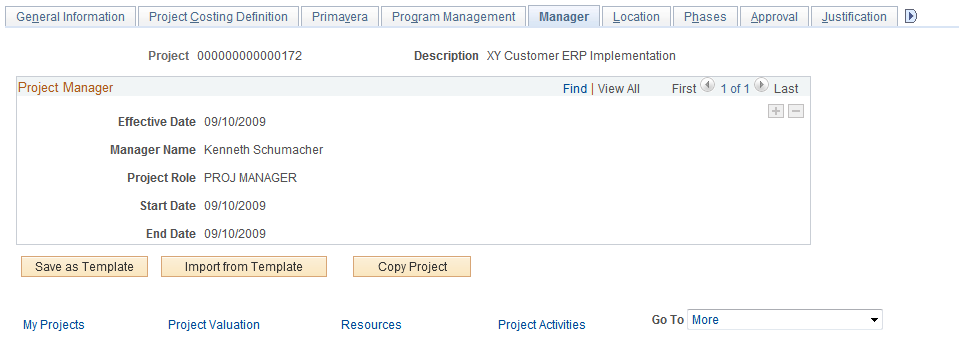
The system adds, modifies, or deletes effective-dated rows on this page in the following way:
When you designate a resource as a project manager on the Project Definitions - Team Detail page in Project Costing, or on the Resource Detail page in PeopleSoft Program Management, the system adds a row with an effective date that is based on the start date of the selected schedule.
When you modify the project manager's role or schedule dates in PeopleSoft Project Costing or PeopleSoft Program Management, the system modifies the existing row.
When you modify the project manager's schedule dates in PeopleSoft Resource Management, the system modifies the existing row.
When you select the Project Manager check box on a different schedule row for the same project manager resource, the system adds a row with an effective date that is based on the start date of the selected schedule row.
When you delete the project manager resource from the list or deselect the Project Manager check box, the system deletes the corresponding project manager row.
You cannot enter or modify project managers on this page. However, if you use PeopleSoft Program Management, you can enter program managers on this page.
See Also, PeopleTools: PeopleSoft Integration Broker
Use the Project Definitions - Location page (PROJECT_LOCATION) to assign the physical location of the project.
Navigation:
This example illustrates the fields and controls on the Project Definitions - Location page. You can find definitions for the fields and controls later on this page.
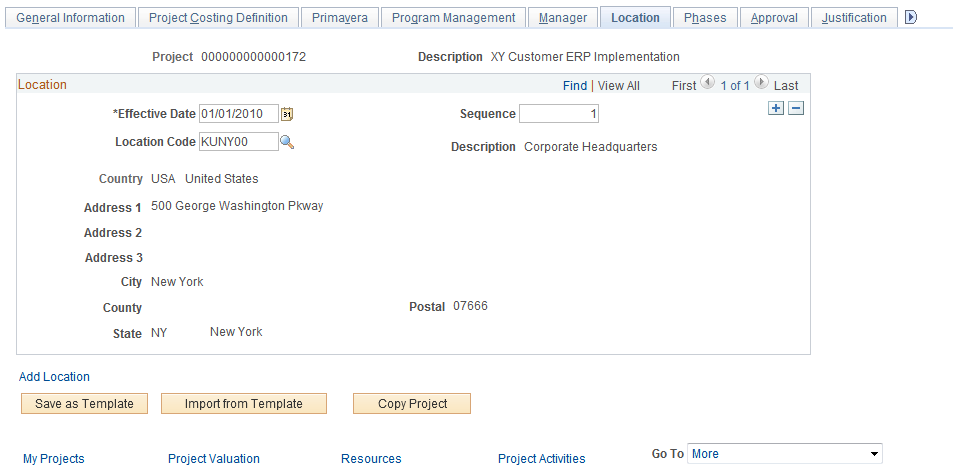
Field or Control |
Description |
|---|---|
Location Code |
Select a location code that has already been defined in the system. The address for this code appears in the bottom half of the page and cannot be edited. |
Add Location |
Click to access the Location Definition page, where you can add or modify a location in the Location table (LOCATION_TBL). See Setting Up Locations. |
Use the Project Definitions - Phases page (PROJECT_SCHED) to track time spent on stages of a project.
Navigation:
This example illustrates the fields and controls on the Project Definitions - Phases page. You can find definitions for the fields and controls later on this page.

Field or Control |
Description |
|---|---|
Phase Type |
Select a phase type to track the time spent on different stages of a project and, for exception reporting, to view the projects that are on schedule. You define phase types on the Phase Types page. See Phase Types. |
Status |
Select a phase status of A (Actual Schedule) or E (Estimated Schedule). |
Use the Project Definitions - Approval page (PROJECT_APPROVAL) to specify which project events require approval, who is authorized to approve the events, and in what order the events must be approved.
Approve a project event or check on approval status.
Navigation:
This example illustrates the fields and controls on the Project Definitions - Approval page. You can find definitions for the fields and controls later on this page.
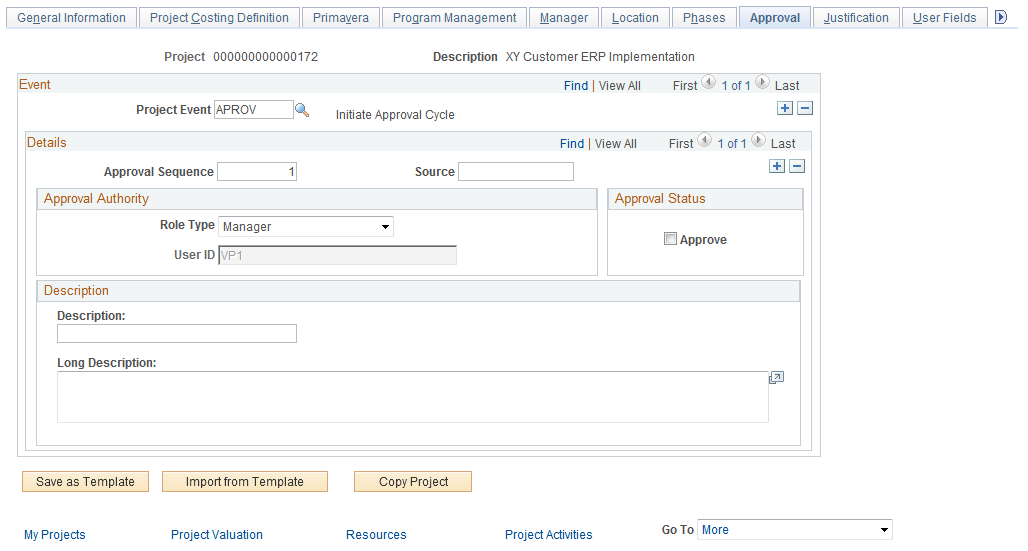
Use the approval sequences that you set up on this page to set up customized workflow processing. For example, when a change in status occurs for which a project event is defined, it can trigger approval workflow that you define for that project event and notify the appropriate people that their approval is required.
Field or Control |
Description |
|---|---|
Project Event |
Select an event to approve, add, or view detailed information. You define project events on the Events page. See Project Events. |
Approval Sequence |
Enter the order in which the specified approvers must approve the project. You can identify as many approvers as necessary, and you can specify more than one approval with the same approval sequence number for the same project event. If you define two approvals for an approval sequence, such as sequence 1, both of the approvals must be completed before completing the approval for approval sequence 2. |
Source |
Enter the person or department that requires this approval. |
Role Type |
Select the role that is authorized to approve the event. Available options are: Manager or Approver: Indicates that anyone assigned that role is authorized to approve the event. Operator: Enables you to assign approval authority to a specific person. The Operator ID field becomes active when you select this option. |
User ID |
Enter an operator ID if you select an option of Operator in the Role Type field. If you select a role type of Operator and leave the User ID field blank, anyone assigned the role of operator is authorized to make the approval. If you selected a role type of Manager or Approver, the User ID field displays the operator ID that is logged into the system. |
Approve |
Select to approve the change in status. |
Note: This page is for informational purposes only; it does not actually enforce the Approval Authority functionality described.
Use the Project Definitions - Justification page (PROJ_JUSTIFY) to if your company employs an approval cycle for projects, enter a reason for justifying a project-related action.
Navigation:
This example illustrates the fields and controls on the Project Definitions - Justification page. You can find definitions for the fields and controls later on this page.
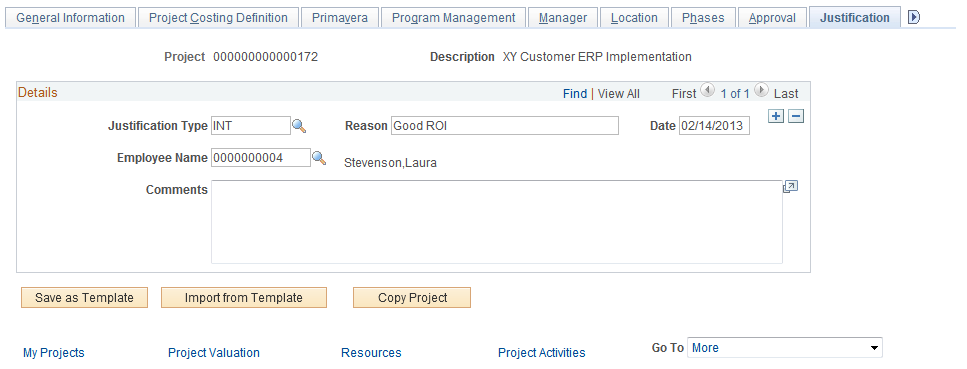
Use this page to provide justification for a project if you use an approval cycle for projects.
Field or Control |
Description |
|---|---|
Justification Type |
Select from the following justification types: EXT: External justification INT: Internal justification IRR: Internal rate of return PAY: Quick payback Available values are based on the translate values in the Justification Type field properties. |
Reason |
Enter a short reason to justify the project. |
Employee Name |
Select the name of the person submitting the justification. |
Use the Project Definitions - User Fields page (PC_PROJ_USER) to specify additional project information for the organization.
Navigation
This example illustrates the fields and controls on the Project Definitions - User Fields page.
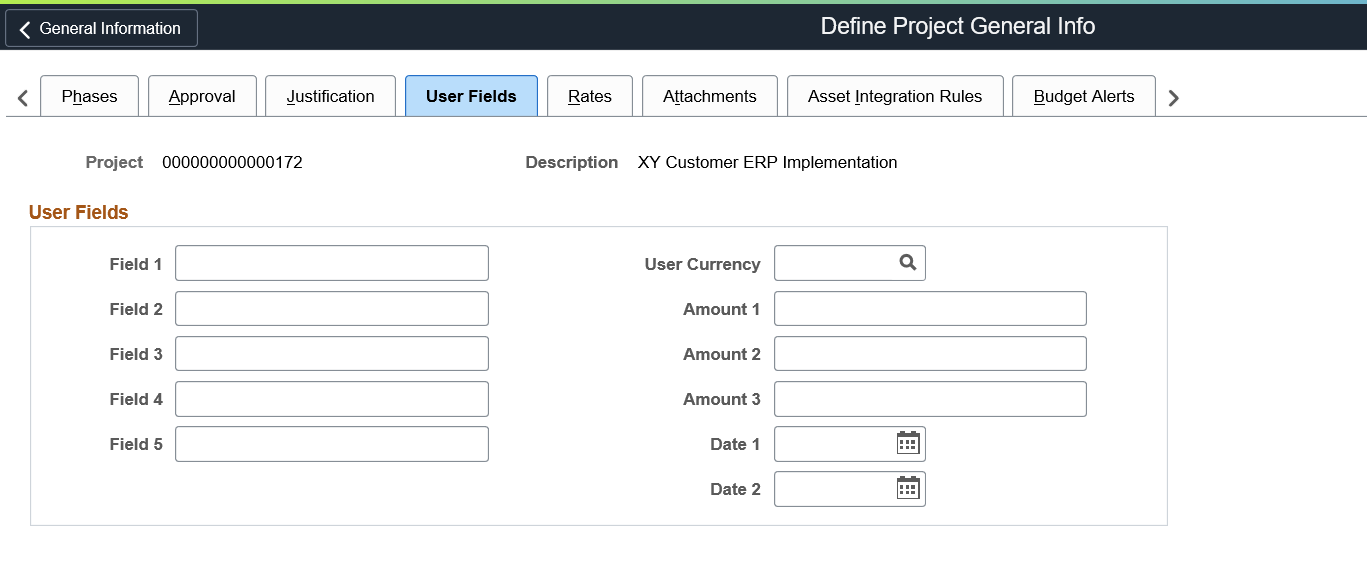
Use the Project Definitions - Rates page (PROJECT_SERVICES) to track billing, costing, and burdening project rates and view contracts integration information that is associated with a project.
Navigation:
This example illustrates the fields and controls on the Project Definitions - Rates page. You can find definitions for the fields and controls later on this page.
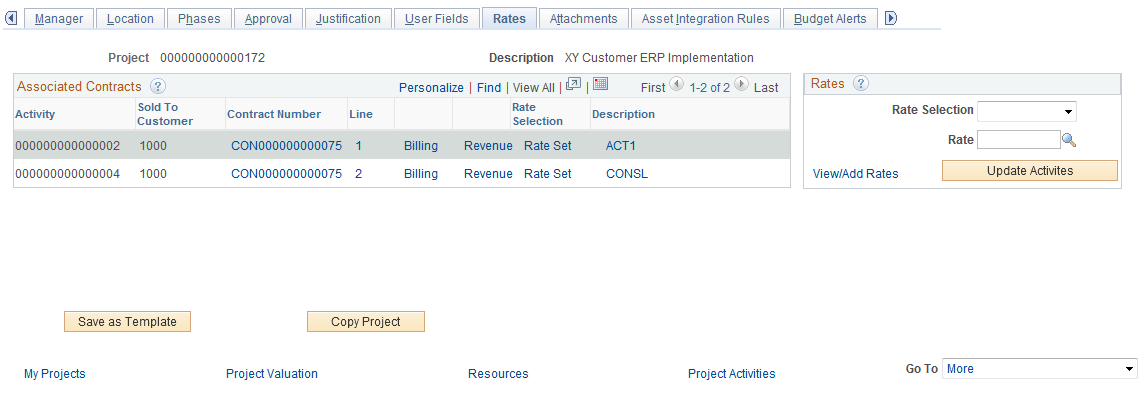
Field or Control |
Description |
|---|---|
Rate Selection and Rate |
Select Rate Set or Rate Plan and select the rate that the system uses as default rates for pricing cost transactions for activities that belong to this project. The system automatically attaches the project's rate selection to the new activities that you create for the project. You can override the default rate set or rate plan at the activity level. The default value for the project rate selection is based on the default rate set or rate plan that is specified for the project type and business unit combination. The system also assigns a default rate selection if you enter a project type for an existing project and these conditions exist:
You can enter a new default rate selection. Available values are based on rate sets or plans that are valid for the business unit and are active on the current date. See Defining Rate Set Categories, Rate Sets, and Rate Plans. |
View/Add Rates |
Click to access the Rate Sets page to view, modify, or create a rate set. |
Update Activities |
Click to update all project activities with the rate selection that appears in the Rate field. This action adds a new effective-dated row to the database with the current effective date activity rate set or rate plan. If the activity already has a rate set associated with the current date, the system replaces the row in the database. If an activity did not previously have a rate selection, and the activity start date is earlier than the current date, a gap will exist between the activity start date and the start of the rate association. After you click the Update Activities button, a message appears indicating the status of updated activities. Note: This action immediately saves the changes to project activities. You cannot cancel the action after you click the Update Activities button. |
Labor % (labor percentage) |
Displays the labor adjustment percentage that the Pricing process uses to calculate new rows for projects that are created from proposals in PeopleSoft Proposal Management if the rate option is AML (Mark Up/Mark Down Labor). This field appears only if you use PeopleSoft Proposal Management. |
Non-Labor % (nonlabor percentage) |
Displays the nonlabor adjustment percentage that the Pricing process uses to calculate new rows for projects that are created from proposals in PeopleSoft Proposal Management if the rate option is AMN (Mark Up/Mark Down Nonlabor). This field appears only if you use PeopleSoft Proposal Management. |
Use the Project Definitions - Attachments page (PROJECT_DOC_01) to attach, view, and delete project-related files.
Navigation:
Note: You must define an FTP server if you want to attach files to projects and activities.
See PeopleSoft Enterprise Financials, ESA and Supply Chain Management Product-Specific Installation Instructions located on Oracle's My Oracle Support website.
Field or Control |
Description |
|---|---|
|
Click the Add Attachment icon to browse to the file that you want to attach, and then click Upload. The system copies the file to the server where your project information resides. If other documents already appear in the Document Attachments grid, add a row to make the Add Attachment icon appear again. |
|
Click the Delete Attachment icon to remove an attachment from the grid. |
|
Click the View Attachment icon to view an attachment. |
 (Information)
(Information)


